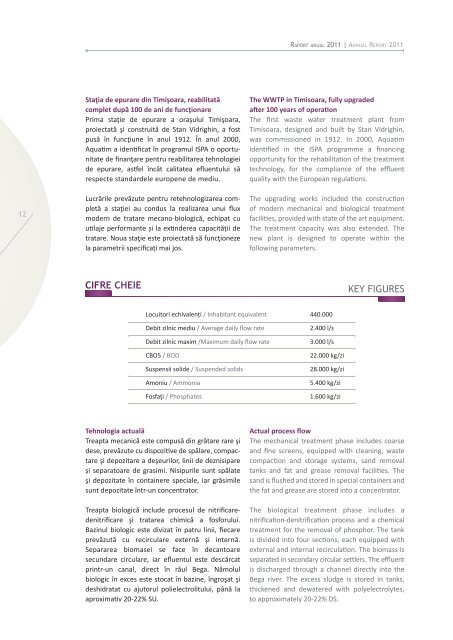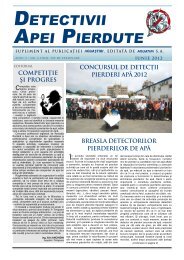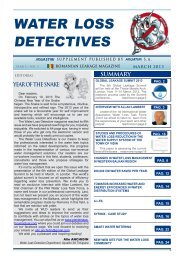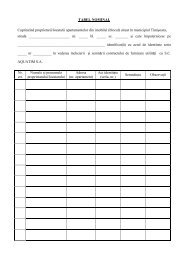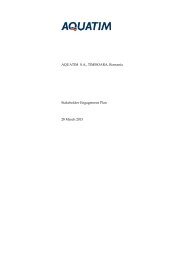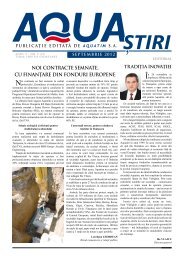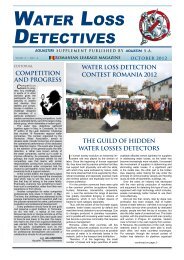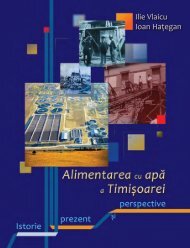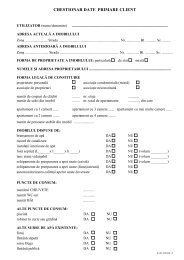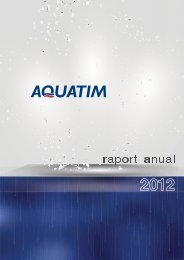Raport anual 2011 .pdf - Aquatim
Raport anual 2011 .pdf - Aquatim
Raport anual 2011 .pdf - Aquatim
Create successful ePaper yourself
Turn your PDF publications into a flip-book with our unique Google optimized e-Paper software.
RapoRt <strong>anual</strong> <strong>2011</strong> | annual RepoRt <strong>2011</strong>12Staţia de epurare din Timişoara, reabilitatăcomplet după 100 de ani de funcţionarePrima staţie de epurare a oraşului Timişoara,proiectată şi construită de Stan Vidrighin, a fostpusă în funcţiune în anul 1912. În anul 2000,<strong>Aquatim</strong> a identificat în programul ISPA o oportunitatede finan ţare pentru reabilitarea tehnologieide epurare, astfel încât calitatea efluentului sărespecte standardele europene de mediu.Lucrările prevăzute pentru retehnologizarea completăa staţiei au condus la realizarea unui fluxmodern de tratare mecano-biologică, echipat cuutilaje performante și la extinderea capacității detratare. Noua staţie este proiectată să funcţionezela parametrii specificați mai jos.The WWTP in Timisoara, fully upgradedafter 100 years of operationThe first waste water treatment plant fromTimisoara, designed and built by Stan Vidrighin,was commissioned in 1912. In 2000, <strong>Aquatim</strong>identified in the ISPA programme a financingopportunity for the rehabilitation of the treatmenttechnology, for the compliance of the effluentquality with the European regulations.The upgrading works included the constructionof modern mechanical and biological treatmentfacilities, provided with state of the art equipment.The treatment capacity was also extended. Thenew plant is designed to operate within thefollowing parameters.CIFRE CHEIEKey FIGuresLocuitori echivalenți / Inhabitant equivalent 440.000Debit zilnic mediu / Average daily flow rateDebit zilnic maxim /Maximum daily flow rateCBO5 / BODSuspensii solide / Suspended solidsAmoniu / AmmoniaFosfaţi / Phosphates2.400 l/s3.000 l/s22.000 kg/zi28.000 kg/zi5.400 kg/zi1.600 kg/ziTehnologia actualăTreapta mecanică este compusă din grătare rare şidese, prevăzute cu dispozitive de spălare, compactareşi depozitare a deşeurilor, linii de deznisipareși separatoare de grasimi. Nisipurile sunt spălateşi depozitate în containere speciale, iar grăsimilesunt depozitate într-un concentrator.Treapta biologică include procesul de nitrificaredenitrificareşi tratarea chimică a fosforului.Bazinul biologic este divizat în patru linii, fiecareprevăzută cu recirculare externă şi internă.Separarea biomasei se face în decantoaresecundare circulare, iar efluentul este descărcatprintr-un canal, direct în râul Bega. Nămolulbiologic în exces este stocat în bazine, îngroşat şideshidratat cu ajutorul polielectrolitului, până laaproximativ 20-22% SU.Actual process flowThe mechanical treatment phase includes coarseand fine screens, equipped with cleaning, wastecompaction and storage systems, sand removaltanks and fat and grease removal facilities. Thesand is flushed and stored in special containers andthe fat and grease are stored into a concentrator.The biological treatment phase includes anitrification-denitrification process and a chemicaltreatment for the removal of phosphor. The tankis divided into four sections, each equipped withexternal and internal recirculation. The biomass isseparated in secondary circular settlers. The effluentis discharged through a channel directly into theBega river. The excess sludge is stored in tanks,thickened and dewatered with polyelectrolytes,to approximately 20-22% DS.


